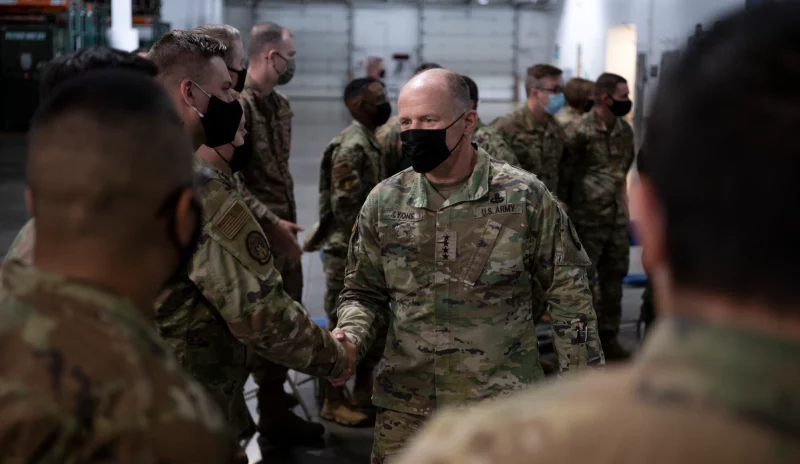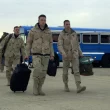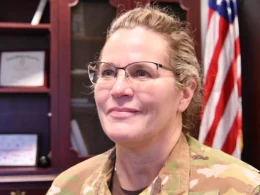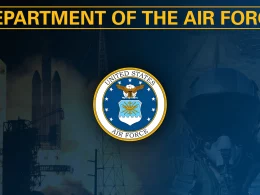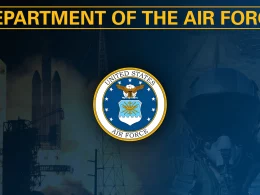SCOTT AIR FORCE BASE, Ill. — The Commander of U.S. Transportation Command (USTRANSCOM) met with Airmen who played a critical role in the recent, historic mission to evacuate Americans and cleared Afghans and foreign nationals out of Afghanistan.
At Travis Air Force Base, California, on Sept. 23, U.S. Army Gen. Stephen R. Lyons, USTRANSCOM commander, highlighted the significant efforts that members of the 821st Contingency Response Group made in helping get more than 124,000 people out of Afghanistan. The 17-day mission, that evacuated about 7,500 civilians per day, was the largest non-combatant evacuation operation airlift in the U.S. military’s history.
“The historic airlift of U.S. citizens and Afghan evacuees was a Joint Force effort, and I could not be more proud of the contingency response airmen from the 821st Contingency Response Group,” Lyons said. “They deployed within hours. They opened the airfield at Kabul (HKIA). They selflessly and courageously provided all of the necessary airfield and ground operations, and they are the reason we were able to safely execute a total of 778 flights evacuating over 124,000 people.”
Approximately 100 contingency response airmen from the 621st Contingency Response Wing ran airfield operations at HKIA after coming in aboard the first flights with paratroopers from the 82nd Airborne Division. The airmen of 821st CRG, which is part of the 621st CRW, serviced, unloaded, repaired and loaded 721 of the 778 aircraft that transited HKIA, servicing an average of four aircraft simultaneously. These airmen arrived at a non-functioning airfield and rapidly repaired radars, airfield lighting, refueling capabilities, ground servicing equipment and vehicles to ensure HKIA could handle operations of this scope and magnitude.
During an interview at the Air Force Association Air, Space and Cyber Conference on Monday, U.S. Air Force Col. Colin McClaskey, 821st CRG deputy commander, who led the contingency response element, said his 89 airmen helped run air traffic control, aircraft loading and other operations at the Kabul airport. He also spoke about the emotional effect of the airlift operation.
“These are significant, traumatic events … lives are truly impacted, [and] unfortunately, in some cases, destroyed. Our Airmen, and all of our partners and allies that were there, they see that. It’s very personal for them,” McClaskey said.
McClaskey said commanders have offered mental health professionals and chaplains for the airmen who participated in the mission.
The opening days of the airlift were marked by a perilous rush of Afghans onto the tarmac at HKIA, and according to intelligence reports, the Islamic State Khorasan (known as ISIS-K) was threatening to attack U.S. forces and those seeking airlift to safety.
Amid this chaos, a C-17 with the call sign ‘Reach 871’ departed HKIA with 823 Afghans on board.
“The iconic photo of hundreds of Afghans on the floor of a C-17 illustrates the desperation, fear and uncertainty of the Afghan people, but also the lifesaving capability and compassion of our military members,” said Lyons Aug. 21, during a Pentagon press briefing. “These herculean efforts underscore the United States’ commitment to our Afghan allies and provide them an opportunity for a new beginning, a safer life, and a better future.”
“I’ve been in for 33 years — 33 years of planning and exercising for these types of operations,” U.S. Air Force Gen. Jacqueline Van Ovost, Air Mobility Command commander, said on Monday at the AFA Air, Space and Cyber Conference. “I had no doubt we’d execute, even at this scale. What blew me away was the compassion our teams gave this effort. I couldn’t be prouder of all partners & airmen, some who are still hard at work.”
At the height of airlift operations out of HKIA, military aircraft were departing the airport every 34 minutes and, in a single day, evacuated more than 21,600 people.
“I’m just reminded that the United States is the only nation capable of rapidly deploying forces and providing nonstop airlift operations at this scale,” said Lyons.
“My commitment is to ensure that airlift is never the constraint in this operation,” Lyons said during his Aug. 21 briefing with the Pentagon press corps. “This incredibly dedicated team of Air Force professionals is the best in the world.”.




